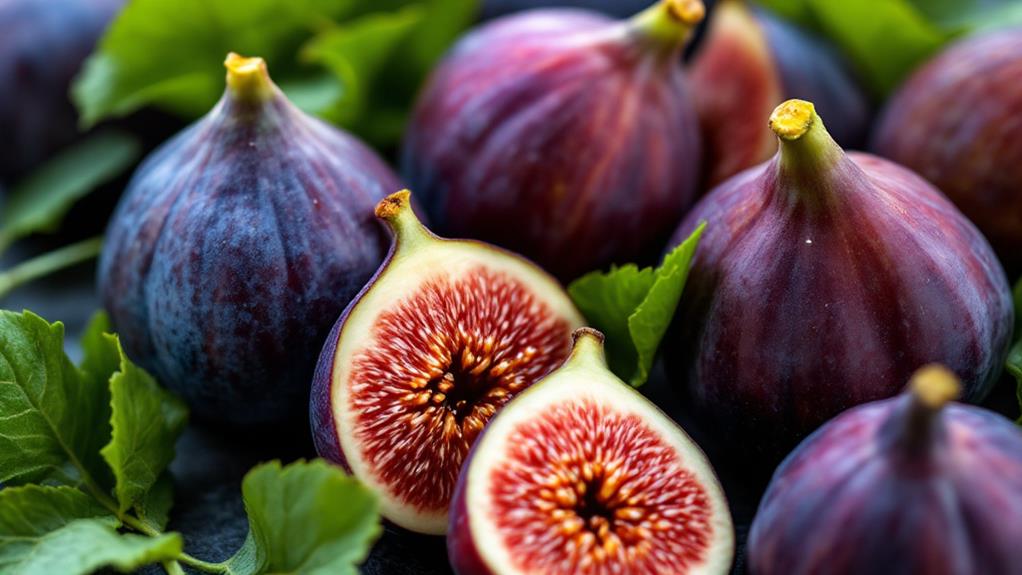Figs: What They Are and How to Use Them in Your Diet

Figs are not just fruits but clusters of inverted flowers and seeds, cherished for their sweet, juicy flavor. They've been cultivated since ancient times, known for their nutritional richness. Eating figs offers fiber, potassium, magnesium, and antioxidants, enhancing digestive and heart health. Enjoy fresh figs raw or add them to salads, or incorporate dried figs into baked goods for natural sweetness. Be mindful of portion sizes, as dried figs are calorie-dense. Fresh figs are ideal for daily snacks, while dried figs add a sweet touch to your meals. Discover more about figs' health benefits and culinary uses.
Understanding Figs
Exploring the world of figs, you'll uncover that these intriguing syconiums are not just fruits but clusters of inverted flowers and seeds. Originating from Western Asia, figs have been cultivated since 5000 B.C., and they hold a significant place in history and culture, symbolizing peace, prosperity, and fertility. The scientific name for the common fig is Ficus carica, and they thrive in warm, dry climates. The Mediterranean region is renowned for its fig cultivation, though California leads in U.S. production.
When investigating fig varieties, you'll encounter the Black Mission, Kadota, Brown Turkey, Calimyrna, and Adriatic. Each offers unique flavors and uses, from fresh consumption to drying. Dried figs are particularly remarkable for their health benefits, as they are rich in dietary fiber, which aids digestion and supports general health.
Integrating figs into your diet can be an enjoyable and healthful experience. Regardless of whether you prefer them fresh or dried, figs can improve your meals with their natural sweetness and rich texture. By understanding their cultivation and varieties, you can appreciate the diverse ways figs contribute to a nutritious and delicious diet.
Nutritional Profile
When considering the nutritional profile of figs, it's clear they hold a wealth of benefits for your diet. Figs come in two forms: fresh and dried, each with its unique advantages. Fresh figs have a lower caloric density, offering about 37 calories per 100 grams, while dried figs pack a punch with 249 calories per 100 grams. This difference stems from the dehydration process, concentrating their nutrients and calories.
Figs are excellent sources of carbohydrates, providing energy in your diet. A medium fresh fig contains around 8 grams of carbohydrates, whereas dried figs, with their concentrated sugars, offer 24 grams of sugar in six pieces. Both fresh and dried figs boast a high fiber content, vital for digestive health. Dried figs, in particular, shine with approximately 9.8 grams of fiber per 100 grams, aiding in weight management and maintaining a healthy digestive system.
Beyond fiber, figs are rich in important minerals like potassium, magnesium, and calcium, which support general well-being. Dried figs have a higher concentration of these vitamins and minerals due to reduced water content. Incorporating figs into your diet can provide these beneficial nutrients with minimal fat and modest protein.
Health Benefits

Embracing the health benefits of figs can greatly improve your well-being. Rich in dietary fiber, figs, especially when dried, offer about 9.8g per 100g, promoting excellent digestive health. This fiber content helps alleviate constipation, making figs a great supplement to your diet if you're looking to maintain a smooth digestive process.
Figs are also a powerhouse of vital minerals, including potassium, which is critical for heart health. Potassium helps regulate blood pressure, ensuring your cardiovascular system functions effectively. If you're concerned about maintaining healthy blood glucose levels, figs might be advantageous. Research suggests that fig leaf extracts can lower blood glucose levels and improve insulin sensitivity, offering potential benefits for managing diabetes.
Moreover, figs are packed with antioxidants such as phenolic acids and flavonoids. These compounds play a significant role in reducing oxidative stress and inflammation in your body, contributing to overall wellness. While figs have a high natural sugar content, providing a quick energy increase, it's significant to enjoy them in moderation. By incorporating figs into your diet, you're not just enjoying a delicious snack but also supporting your body's health in numerous ways.
Medicinal Uses
Exploring the medicinal uses of figs reveals a variety of health benefits that might surprise you. If you're dealing with diabetes, fig leaf extract could be a game-changer. It has demonstrated hypoglycemic effects in diabetic patients, potentially lowering after-meal glucose levels and reducing insulin needs. This extract might inhibit glucose production in the liver, helping you manage blood sugar levels more effectively.
But that's not all figs have to offer. Their high fiber content supports digestive health, making them a natural remedy for constipation. By including figs in your diet, you can promote regularity and improve your general digestive system. Furthermore, studies suggest that fig leaves possess anti-inflammatory properties. This means they could contribute to health improvements, particularly if you're managing chronic conditions that involve inflammation.
While some animal studies hint at the aphrodisiac potential of figs, more research is necessary to confirm these effects in humans. However, the potential health benefits of figs and fig leaf extract are clear. By incorporating them into your diet, you may find new ways to support your health and well-being naturally. Regardless of whether you're aiming to improve digestion or stabilize blood sugar, figs offer a promising option.
Side Effects

Figs, while packed with health benefits, can also present some side effects if consumed excessively. Thanks to their high fiber content, figs can act as a natural laxative, leading to diarrhea if you're not careful, especially with dried figs. If you're on blood-thinning medications, you should be aware that figs are high in vitamin K, which can interfere with these treatments. It's significant to maintain a consistent intake to avoid any complications.
For those with allergies, figs might pose a problem. If you're allergic to birch pollen or latex, you could experience allergic reactions to figs. A considerable percentage, around 78%, of birch pollen allergy sufferers also react to fresh figs. Furthermore, figs contain high levels of natural sugar, particularly in dried varieties. This can complicate matters for diabetics, as it requires careful monitoring of blood sugar levels.
Overindulging in figs can also lead to increased calorie intake, which could be an issue if you're watching your weight. Dried figs are calorie-dense, with about 249 calories per 100 grams. Keeping an eye on your portion sizes can help you enjoy figs without unwanted side effects.
Dietary Recommendations
When you're planning to include figs in your diet, it's vital to think about some key dietary recommendations to improve their benefits. Figs, regardless of being fresh or dried, offer high fiber and nutrient content, but you'll need to manage your intake to enjoy them without overloading on sugar and calories.
- Incorporate fresh figs: Aim for 1-2 fresh figs daily to increase your fiber intake without adding too much sugar.
- Opt for dried figs: Limit to ¼ cup per day, as they contain more calories and sugar, making moderation important.
- Pair figs wisely: Combine them with nuts or yogurt for a balanced snack, augmenting their nutritional value.
- Consider dietary restrictions: If you have diabetes or other dietary restrictions, consult your healthcare provider to determine the right amount for you.
- Monitor portion sizes: Especially with dried figs, keep an eye on calories and sugar to avoid exceeding your dietary needs.
Fresh figs can be a delightful supplement to salads, desserts, or even as a natural sweetener in recipes. Meanwhile, dried figs offer a convenient, energy-raising snack that fits into a balanced diet. Always prioritize moderation and consult with a healthcare provider when necessary.
Preparation Methods

To truly savor the unique flavor and nutritional benefits of figs, a variety of preparation methods can be employed. Fresh figs are incredibly versatile; you can enjoy them raw as a low-calorie snack or slice them into salads for a sweet flavor improvement. Make sure to wash them gently under cold water to remove any dirt. To keep them fresh longer, store fresh figs in the refrigerator, and they'll last about 5-7 days.
Dried figs offer another delightful culinary option. Though higher in sugar, they can be chopped and incorporated into baked goods like muffins or energy bars, providing natural sweetness and fiber. If you're in the mood for a cozy dessert, try roasting figs with honey and cinnamon. This method amplifies their sweetness and pairs beautifully with savory cheese for a perfect savory and sweet pairing.
Don't overlook fig leaves, which present an intriguing culinary option. They can be used as wraps for meat or rice dishes or brewed into a tea, offering extra health benefits. Regardless of whether you opt for fresh or dried figs, these preparation methods allow you to investigate the diverse ways figs can enrich your diet.
Varieties of Figs
After investigating the diverse ways to prepare figs, it's interesting to contemplate the different varieties that can improve your culinary experiences. Each type offers unique flavors and textures, enhancing both sweet and savory dishes. Let's explore some popular varieties of figs you might want to try.
- Black Mission Figs: With their dark purple exterior and sweet flavor, they're perfect for fresh consumption and making dried figs.
- Kadota Figs: Known for their yellow-green skin, these figs have a mild sweetness and firm texture, ideal for canning and fig jam.
- Brown Turkey Figs: These figs have a purple-brown skin and a milder taste, making them versatile for fresh and cooked dishes.
- Calimyrna Figs: Featuring green skin and a nuttier flavor, they're popular in dried fruit products and add a unique twist to recipes.
- Adriatic Figs: With yellow-green skin and a lively pink interior, they offer a stronger flavor, perfect for desserts and fig jam.
Incorporating these varieties into your diet can transform ordinary meals into extraordinary culinary experiences. Regardless of whether you're snacking on dried figs or spreading fig jam over toast, each type brings something special to the table.
Cultural Significance

Throughout history, figs have held a prominent place in assorted cultures, symbolizing peace, prosperity, and fertility. Originating in Western Asia, figs are among the initial domesticated plants, with evidence dating back to 5000 B.C. In ancient cultures like Egypt and Greece, figs often appeared in religious texts and were linked to different deities, underscoring their cultural significance. These societies viewed figs not only as sacred but also as crucial to their diet and traditions, celebrating their role in agriculture and spiritual life.
Figs have also played a significant part in religious narratives. They're mentioned in the Bible and Islamic scriptures, highlighting their importance across spiritual domains. These references further cemented figs' place in cultural significance, as they became symbols of divine favor and abundance in these religious contexts.
When early European settlers arrived in America in the 1500s, they introduced figs, embedding them into the agricultural landscape, especially in California. Today, figs are celebrated for their culinary versatility and historical role. They continue to influence diets and traditions worldwide, reminding us of their enduring impact on human culture and agriculture. By incorporating figs into your diet, you're embracing a rich tapestry of history and tradition.




